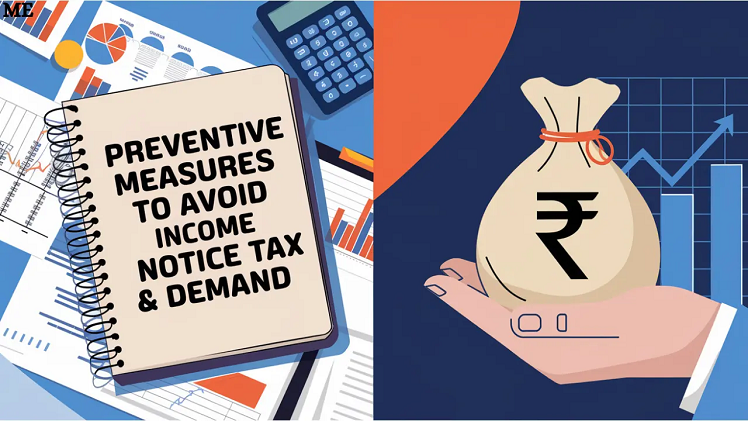Income Tax Notice for Salaried Employees 2025 – Complete Guide, Reasons, Types & Solutions

Receiving an income tax notice salaried employees can cause anxiety among salaried employees. Many individuals assume that if their employer deducts TDS (Tax Deducted at Source), they are automatically compliant with the Income Tax Department. However, that is not always the case. The Income Tax Department of India may issue notices for several reasons—ranging from mismatched information to missed filings or verification requests.
In this comprehensive guide, we will explain Instagram bio why salaried employees receive income tax notices, what types exist, how to respond correctly, and what documents are necessary to handle the situation efficiently.
Understanding Income Tax Notices
An income tax notice salaried employees is an official communication sent by the Income Tax Department (ITD) to taxpayers. It is usually sent to verify details, correct discrepancies, or demand additional information.
For salaried employees, this can occur even when TDS is deducted by their employer. Errors in reporting, non-filing of returns, incorrect PAN usage, or mismatched income details can all trigger notices.
Key Reasons Why Salaried Employees Receive Income Tax Notices
Below is a detailed explanation of common reasons salaried individuals may receive an income tax notice salaried employees in India:
| Reason | Description | Example |
|---|---|---|
| Mismatch in Form 26AS or AIS | When the income shown in the ITR does not match the records in Form 26AS or Annual Information Statement. | If employer reports ₹10,00,000 salary, but ITR shows ₹9,50,000. |
| Non-filing of ITR | Failing to file returns despite having taxable income. | Employee earning above ₹2.5 lakh did not file ITR. |
| Incorrect TDS claims | Claiming TDS that is not reflected in Form 26AS. | Showing TDS from multiple companies without proof. |
| High-value transactions | Large financial transactions not reported in ITR. | Buying property or investing over ₹10 lakh without declaring. |
| Discrepancy in deductions | Incorrect or inflated claims under Section 80C, 80D, etc. | Claiming ₹2 lakh under 80C instead of ₹1.5 lakh limit. |
| Random scrutiny | Selected randomly for verification. | ITD picks returns for random checks. |
| Arrears or double salary | Receiving arrears or two salaries during job change. | Two Form 16s in one year but only one shown in ITR. |
| Late filing or incorrect verification | Return filed after the due date or not verified electronically. | Filing without completing e-verification. |
Types of Income Tax Notices for Salaried Employees
The Income Tax Department issues different types of notices based on the nature of discrepancies. Understanding these helps taxpayers take the right corrective measures.
| Section | Type of Notice | Purpose | Action Required |
|---|---|---|---|
| Section 139(9) | Defective Return Notice | When the ITR filed has errors or incomplete details. | Correct and re-file within 15 days. |
| Section 143(1) | Intimation Notice | When there’s a difference between your filed return and ITD’s calculation. | Accept or disagree online. |
| Section 143(2) | Scrutiny Notice | Issued to verify details and accuracy of your return. | Submit proofs and documents. |
| Section 142(1) | Inquiry Notice | Asking for more information before assessment. | Respond with required documents. |
| Section 156 | Demand Notice | Issued if additional tax is due. | Pay the demanded amount. |
| Section 245 | Adjustment Notice | Adjusting refund against previous dues. | Agree or object online. |
| Section 148 | Income Escaping Assessment | When income was under-reported or not disclosed. | File a fresh ITR for that year. |
Step-by-Step Process to Respond to Income Tax Notices
It’s crucial to respond promptly and accurately once a notice is received. Ignoring it can lead to penalties or legal consequences.
1. Identify the Type of Notice
Read the notice carefully to understand which section of the Income Tax Act it refers to.
2. Verify the Authenticity
Log in to the Income Tax e-filing portal → Navigate to ‘e-Proceedings’ → Check if the notice is genuine.
3. Analyze the Issue
Compare your ITR details, Form 16, Form 26AS, and AIS. Identify mismatches or discrepancies mentioned in the notice.
4. Prepare a Response
Prepare a detailed response with explanations and supporting documents.
5. Submit Reply Online
Go to:
e-Proceedings → View Notices → Submit Response
Attach relevant documents (salary slips, TDS certificates, proofs of deductions).
6. Await Confirmation
Once submitted, track the status of your response. If the department needs clarification, additional queries will appear under “e-Proceedings.”
Documents Required to Respond
| Document | Purpose |
|---|---|
| Form 16 | Verification of salary and TDS details. |
| Form 26AS / AIS | Matching reported income and taxes paid. |
| Bank Statements | Proof of income, interest, or transactions. |
| Salary Slips | Salary proof and deductions validation. |
| Investment Proofs | Validation of 80C, 80D, and other deductions. |
| PAN Card and Aadhaar | Identity verification. |
Common Scenarios and Solutions
Here are a few practical examples salaried employees may face:
| Scenario | Possible Notice | Action to Take |
|---|---|---|
| Salary credited from two employers in one year | Section 143(2) scrutiny | Combine both Form 16s and file revised return. |
| TDS deducted but not reflected in Form 26AS | Section 143(1) | Contact employer to correct TDS return. |
| Claiming false deductions | Section 142(1) | Provide correct proofs or revise ITR. |
| Refund adjusted against past dues | Section 245 | Accept or file objection on portal. |
| Income not disclosed (FD interest, etc.) | Section 148 | File updated ITR including missed income. |
Penalties for Non-Compliance
If salaried employees ignore income tax notices, the following penalties or legal actions can be applied:
| Offense | Penalty/Consequence |
|---|---|
| Failure to respond within time | Fine up to ₹10,000 under Section 271(1)(b). |
| Non-filing or incorrect filing | Penalty under Section 234F (up to ₹5,000). |
| Concealment of income | 100–300% of tax evaded as penalty. |
| False information submission | Prosecution under Section 277. |
| Continued non-compliance | Legal notice or court summons. |
Preventive Measures to Avoid Income Tax Notices

To ensure a stress-free tax experience, salaried employees should adopt these preventive steps:
-
File ITR on time every assessment year.
-
Verify TDS and Form 26AS before filing.
-
Report all income sources (salary, rent, interest, etc.).
-
Avoid false deductions or inflated claims.
-
Maintain income proofs and receipts for at least 6 years.
-
Link PAN with Aadhaar to avoid invalid filings.
-
Cross-check AIS and TIS (Taxpayer Information Summary) for accuracy.
How to File a Revised Income Tax Return
If you discover an error after receiving a notice, you can file a revised return under Section 139(5).
Steps:
-
Visit incometax.gov.in
-
Login → e-File → Income Tax Return → File Revised ITR
-
Select “Revised Return” option and mention acknowledgment number of original return.
-
Correct the discrepancies and submit.
How to Check Income Tax Notice Online
You can verify and track your notice online using these steps:
-
Login to Income Tax e-Filing Portal
-
Go to ‘e-Proceedings’ → ‘View Notices’
-
Click on the notice → Download PDF → Review section mentioned.
-
You can also check via email or SMS alerts from “ITD” or “noreply@incometax.gov.in”.
Important Tips for Salaried Employees
-
Always download Form 16 from your employer every year.
-
Verify that your PAN and TDS are correctly reported by the employer.
-
Use registered tax professionals if unsure how to respond.
-
Keep all tax communication saved in PDF format for future reference.
-
Reconcile your Form 26AS, AIS, and bank data annually.
Recent Updates for AY 2024–25 (Assessment Year 2025)
| Update | Details |
|---|---|
| AIS expansion | Now includes overseas remittances, dividends, and mutual fund data. |
| AI-based scrutiny | ITD uses AI tools to detect discrepancies in ITR filings. |
| New penalty slabs | Non-response within 30 days can attract direct penalties. |
| e-Proceedings portal upgrades | Simplified document upload and tracking. |
| PAN-Aadhaar linking | Mandatory before return submission. |
What to Do If You Receive a Demand Notice
If you receive a demand notice under Section 156, follow these steps:
-
Verify computation on ITR portal.
-
If correct, pay tax using Challan 280 at tin-nsdl.com.
-
If incorrect, raise a rectification request under Section 154.
-
Always submit proof of payment or acknowledgment in e-Proceedings.
Difference Between Scrutiny Notice and Demand Notice
| Criteria | Scrutiny Notice (Sec 143(2)) | Demand Notice (Sec 156) |
|---|---|---|
| Purpose | To verify the accuracy of ITR details. | To demand tax payment. |
| Trigger | Random or discrepancy-based selection. | Computation shows tax underpayment. |
| Response | Provide documents and clarification. | Pay dues or contest calculation. |
| Penalty Risk | Low if compliant. | High if ignored. |
Role of Employer in TDS Compliance
Employers play a crucial role in ensuring accurate TDS deduction and reporting.
| Employer Responsibility | Impact on Employee |
|---|---|
| Deducting correct TDS monthly | Prevents shortfall in tax. |
| Filing quarterly TDS returns | Ensures Form 26AS accuracy. |
| Issuing Form 16 on time | Helps file accurate ITR. |
| Reporting correct PAN | Avoids TDS mismatch. |
If your employer fails to comply, discrepancies may arise in your Form 26AS, which can trigger notices.
Sample Response Format for Income Tax NoticeWhen to Seek Professional Help
You should seek help from a Chartered Accountant (CA) or tax expert in these cases:
-
Notice under Section 143(2) or 148 (Scrutiny or Reassessment)
-
Large tax demand or underreporting cases
-
Income from multiple employers or foreign income
-
Errors in TDS or unreported income
A professional can file replies, represent you before the IT Department, and ensure compliance.
FAQ Section: Income Tax Notice for Salaried Employees
1. What should I do first after receiving an income tax notice?
First, verify the notice on the Income Tax e-filing portal to confirm its authenticity, then read the section carefully to understand its purpose.
2. Can salaried employees get income tax notices even if TDS is deducted?
Yes, notices can be issued for mismatched income, errors in return, unreported income, or incorrect deductions—even if TDS was deducted.
3. How long does the IT Department take to resolve a notice?
Generally, 30 to 90 days, depending on the case complexity and your timely response.
4. What happens if I ignore a tax notice?
Ignoring a notice can lead to penalties, prosecution, or even tax recovery proceedings.
5. How can I avoid getting notices in the future?
Ensure timely filing, accurate data, and reconciliation between Form 16, 26AS, AIS, and your ITR before submission.
6. Is it possible to respond to the notice offline?
No, all responses must be submitted online through the e-Proceedings portal.
7. Can a CA respond to the notice on my behalf?
Yes, a Chartered Accountant can legally represent you before the IT Department.
8. What if my employer’s TDS is not reflected in Form 26AS?
Contact your employer immediately to correct their TDS filing, then request rectification in your ITR.
9. How can I check my pending notices?
Login → Dashboard → e-Proceedings → View Notices on the Income Tax Portal.
10. What is the deadline to respond to a notice?
Usually within 15 to 30 days from the date of notice issuance.
Conclusion
Receiving an income tax notice does not always imply wrongdoing. For salaried employees, it often arises from minor mismatches or documentation issues. What matters is timely and accurate response.
By maintaining proper tax records, reconciling TDS data, and filing returns accurately each year, employees can avoid unnecessary complications. In case of doubt, consulting a tax professional ensures peace of mind and full compliance with the law.




